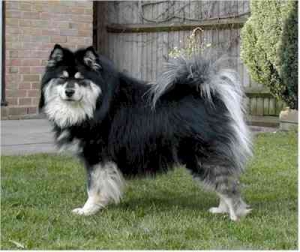The breed standard as used for judging/breeding the Finnish Lapphund in the UK is held by the Kennel Club
There is also a European Standard used by FCI countries including Finland
The Kennel Club’s breed standard for the Finnish Lapphund:
General Appearance
Strongly built dog, smaller than medium size. Body slightly longer than height at withers. Coat long and profuse.
Characteristics
Tendency to herd.
Temperament
Intelligent, brave, calm, faithful. Suitable as companion and watch dog.
Head and Skull
Strong featured, comparatively broad, bitches more refined, forehead slightly rounded; stop clearly defined. Muzzle shorter than skull, straight and slightly tapering when viewed from both above and side. Nose and eye rims as dark as compatible with coat colour.
Eyes
Oval shaped, dark brown or harmonising with coat colour. Expression soft and friendly.
Ears
Erect or semi-erect. Medium size, set well apart, broad at base and very mobile.
Mouth
Jaws strong with perfect, regular and complete scissor bite, i.e. upper teeth closely overlapping lower teeth and set square to the jaw. Lips tight.
Neck
Medium long, strong, covered with thick hair.
Forequarters
Shoulder and upper arm of approximately equal length. Shoulder moderately laid back and forming a rather open angle with upper arm. Legs well boned, strong, straight and parallel. Elbow placed slightly lower than the lower edge of brisket. Pasterns of medium length, flexible and slightly sloping.
Body
Firm. Back strong, straight and broad. Moderate spring of rib. Brisket deep and long almost reaching the level of the elbow. Depth of body slightly less than half the height at withers. Forechest clearly defined, of moderate width. Loin short and muscular. Slight tuck up. Croup medium length, well defined and slightly sloping. The body, measured from point of shoulder to point of buttock, slightly longer than height at withers.
Hindquarters
Strong boned, powerful, straight and parallel when viewed from behind. Moderate angulation. Muscular thighs. Hocks relatively low set.
Feet
Well arched, oval, covered with thick hair.
Tail
Medium length, high set, covered with profuse, long hair. Carried curved over the back or side when the dog is moving. May hang when the dog is at rest. Tip of tail may have a ‘J’ formed hook.
Gait/Movement
Effortless, brisk, agile and straight. Medium length of stride, changing easily from trot to gallop.
Coat
Profuse. Outer coat long, coarse and straight. Shorter on the head and front of legs. Undercoat soft and dense. Males should have a more abundant mane.
Colour
All colours allowed but main colour must dominate. Markings differing from the main colour are permitted on head, neck, chest, legs, tail and underside of body.
Size
Ideal height at withers, dogs 49cm (19.25 ins); bitches 44cm (17½ ins), with an allowance of 3cm (1¼ ins) either way. Type is more important than size.
Faults
Any departure from the foregoing points should be considered a fault and the seriousness with which the fault should be regarded should be in exact proportion to its degree and its effect upon the health and welfare of the dog and on the dog’s ability to perform its traditional work.
Note
Male animals should have two apparently normal testicles fully descended into the scrotum.

